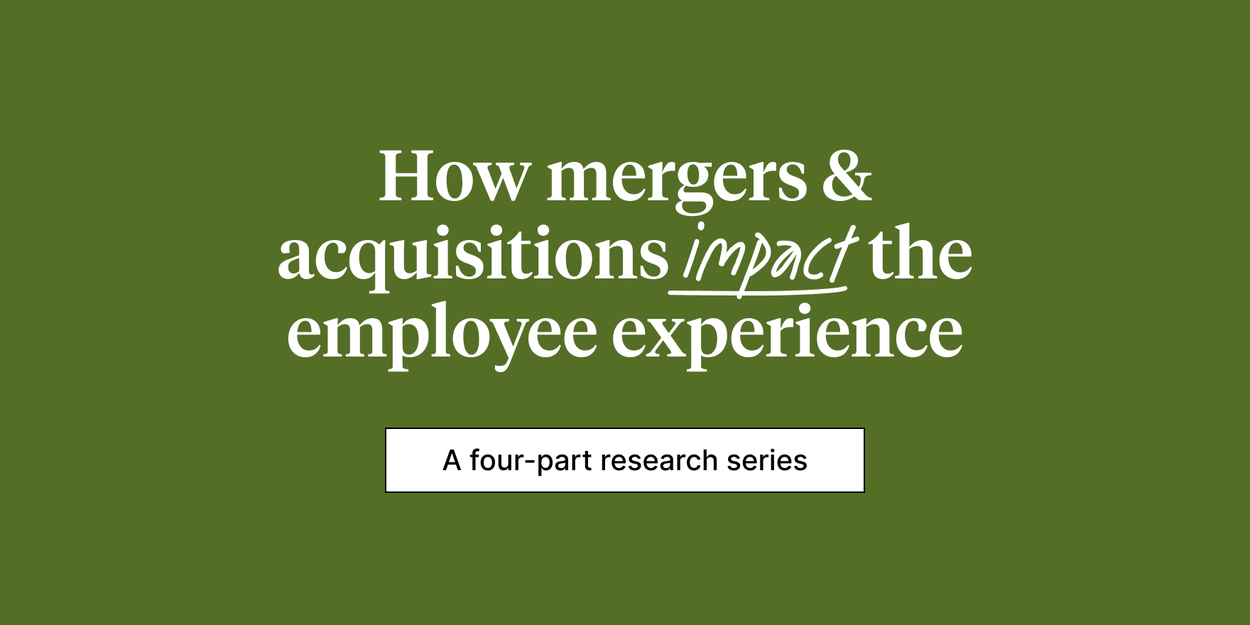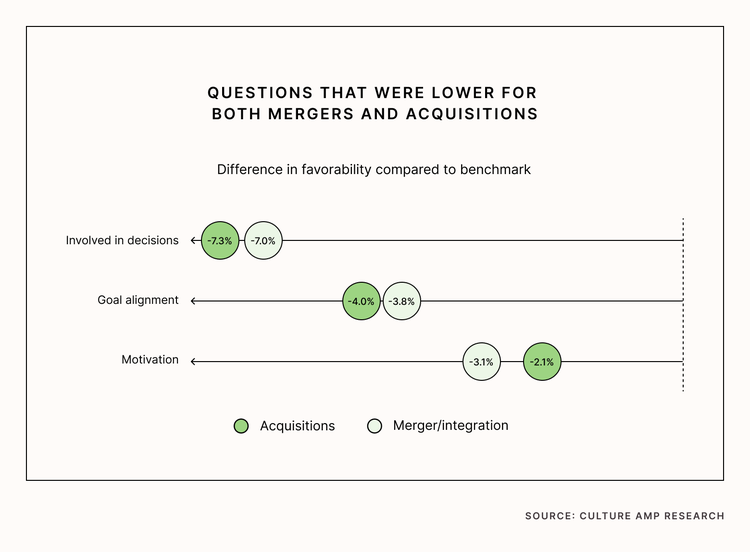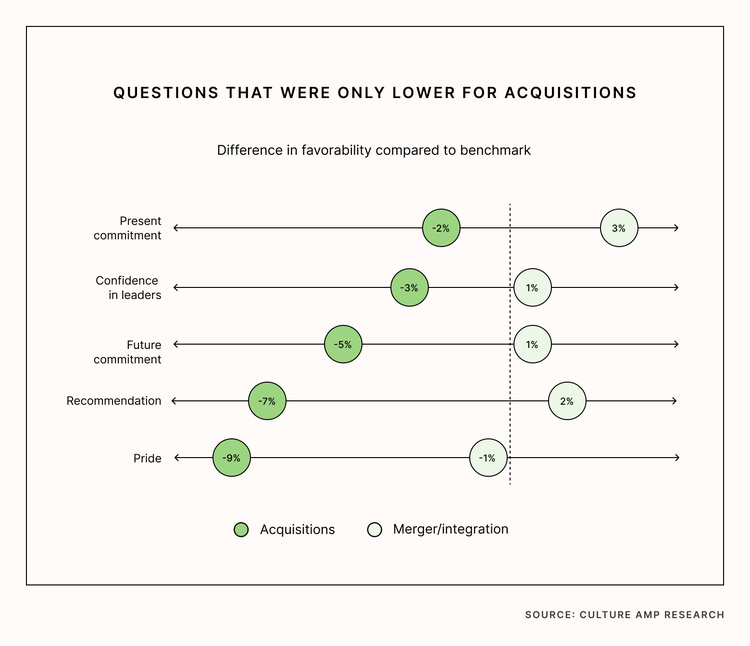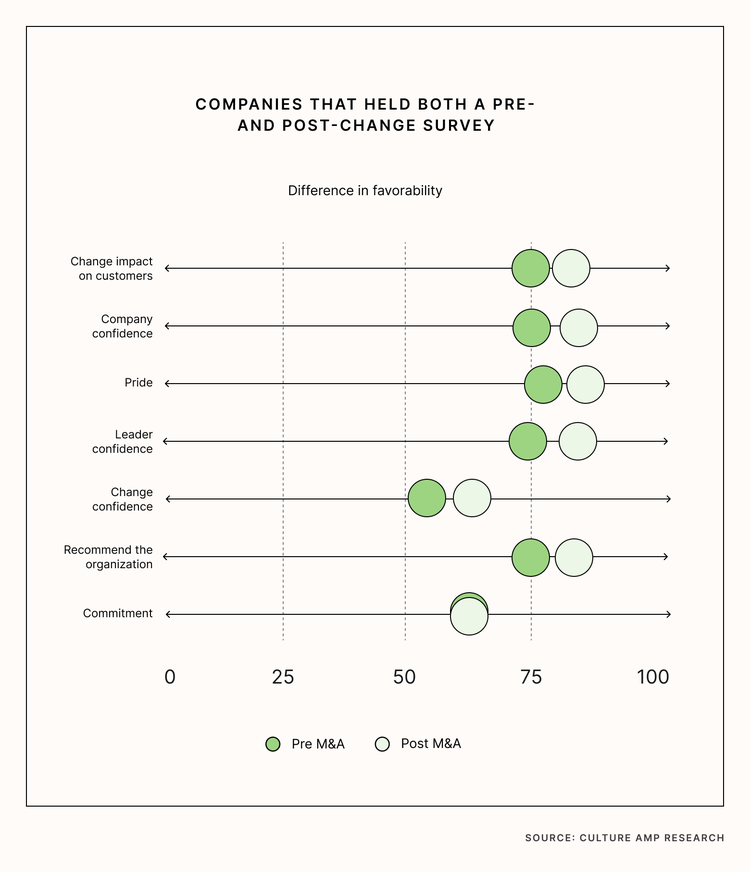
How mergers and acquisitions impact the employee experience

Written by

Senior Content Marketing Manager, Culture Amp

Senior People Scientist and Research Manager, Culture Amp
Mergers and acquisitions are often treated as two parts of a related process, so much so that they’re abbreviated together (M&A).
In general, mergers and acquisitions refer to “the consolidation of companies or their major business assets through financial transactions between companies.” It’s a broad term that covers scenarios such as:
- When one company purchases another company (acquisition)
- When one company acquires a significant amount of another company’s assets and liabilities (acquisition)
- When two companies decide to combine to form a new company (merger)
That being said, mergers and acquisitions aren’t the same thing. As you can see above, acquisitions are when one company “acquires” another company, absorbing it as part of the same corporate entity. Mergers, on the other hand, occur when two companies come together to create a new entity. These two practices are different, and thus, it’s logical to assume that their impact on the employee experience differs as well.
In the fourth and final part of our research series exploring the impact of change on employee engagement, we investigate how the employee experience changes when a company goes through a merger versus when they go through an acquisition.
Methodology
First, we identified companies that were going through a merger or an acquisition. Our people scientists used what Culture Amp calls Change surveys to identify which companies were going through a merger compared to an acquisition.
To make this determination, we looked at the language the company used in their change survey. For example, if their questions included words like “integrate” or “merge,” we classified the change as a “merger.”
For companies going through mergers and acquisitions, we looked at their survey scores for two types of surveys:
- Change surveys (including Pre- and Post-change surveys)
- Employee engagement surveys
We looked at results from both types of surveys to assess employee attitudes before and after a merger or acquisition. Some companies only conducted Pre-change surveys or Post-change surveys, some conducted both. By looking at the difference in favorability from the benchmark for these surveys, we could assess how merger/acquisitions affect how employees feel about the employee experience at their organization.
3 insights into the impact of mergers or acquisitions on the employee experience
Below, we share three key insights into how the employee experience of those going through a merger versus an acquisition.
1. Both mergers and acquisitions negatively impact employees’ perceptions of decision-making, alignment, and motivation

When we look at the employee engagement survey results, we see that both mergers and acquisitions lead to a slight boost in company confidence compared to the benchmark. This is likely because senior leaders have emphasized to employees the financial benefits of the M&A for the organization going forward. Most employees are inclined to trust what they’ve been told, mainly because they don’t have enough details to question it.
However, there are also key areas where scores decline, particularly around how involved employees feel in decision-making and if they feel like their work contributes to the company’s goals. Employees are likely to feel “left out” of M&A-related decisions that affect them and unsure how their work aligns with the company’s new vision. This has a secondary effect on employee motivation, which experiences a small but significant drop.
💡Insight: To ensure that employees feel included in the process, leaders should consult with their employees on how to roll out the M&A most effectively. They should also clearly explain the critical role that employees will play in achieving the goals of the newly formed organization.
Organizations should also consider hosting open Q&A sessions and regular consultation sessions to address employee concerns with a representative sample of the workforce. This can help alleviate some of the doubt and confusion surrounding the decision. Additionally, updating job architectures as soon as possible will ensure that employees understand how their responsibilities will or won’t change following the M&A.
2. Employees undergoing an acquisition generally feel more negatively than those going through mergers
Employee engagement scores are significantly lower for companies going through an acquisition than those going through a merger.

We found that companies going through acquisitions had lower levels of present commitment, confidence in leaders, future commitment, recommendation, and pride. Why would this be?
Well, companies going through an acquisition can fall on either side – the acquirer or the acquiree. However, we would expect companies to be more likely to survey employees in the acquired organization than in the acquiring organization.
As such, it makes sense that employees going through an acquisition are less likely to identify with the new organization and the new leaders. Moreover, they’re likely to lose their sense of pride and connection toward their current organization, as they expect it to soon be dissolved into the new organization. These employees probably feel significant uncertainty and insecurity. Morale may be low, as they don’t know what their next company will be like, how their job will change, if they’ll fit in well with the company’s culture – or if the acquiring company will even retain them.
💡Insight: We should expect employees who are a part of the acquired organization to be more uncertain about the future, which is why engagement and confidence in leadership tend to drop more for acquisitions than mergers. The more leaders can assure employees that the acquisition will benefit them in the long run, the more likely they will embrace the change. By the same token, leaders should also communicate openly and honestly about any uncertainties or ambiguities surrounding the acquisition.
3. The right approach to change management can help buffer against any adverse impacts of going through a merger or acquisition
Out of the companies we looked at, we identified 30 companies undergoing an acquisition and 30 undergoing a merger that conducted both a Pre-change survey and a Post-change survey. We found no significant difference in favorability for these companies before and after the change.

This finding suggests that how employees feel when a change is announced is how they feel once the change has been implemented. The companies that had the foresight to run both pre- and post-change surveys are likely keeping a more watchful eye on change management, which is why their employees remain positive throughout (and despite) the change.
💡Insight: Companies planning to go through a merger or acquisition should take great care in communicating the initial announcement, because it can significantly impact how your employees feel throughout and after the change process. Furthermore, it’s a good idea to keep an eye on how your teams deal with the change and continue collecting feedback throughout the process.
Keep your employee experience at the forefront when going through mergers and acquisitions
When companies experience change, the employee experience changes, too. This is true whether a company is going through a merger or an acquisition. Some of the impacts are the same for companies going through both mergers and acquisitions, while others are unique to only mergers or acquisitions.
That being said, our data suggests that it's important to help employees understand the value of the change (and their role in it) upfront – because how they feel before the M&A is likely how they will feel post-M&A. Organizations in our sample that held both a Pre-change and Post-change survey saw no significant changes in their employee experience scores.
Want to stay ahead of change? Understand and mitigate the negative effects of M&As with employee engagement tools that help you measure employee sentiment through the ups and downs of the entire employee experience.
This wraps up our research series exploring the relationship between employee engagement and performance! If you want to learn more, read the rest of the series:
- Context: Improving employee engagement during times of change
- The impact of layoffs on the employee experience
- Company layoffs: Dispelling 4 common myths
To ensure you don’t miss out on any of Culture Amp’s future research, subscribe to the People Geekly newsletter! We’ll send you the latest HR insights, news, and events – straight to your inbox. You can also check out our eBook, "How to manage company culture during mergers and acquisitions."


